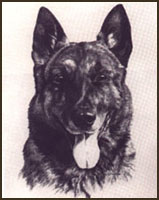
About the breed
In
search of a solid stable working dog, many people have shied away from the
Belgian Malinois because they are believed to be too hard to handle, and the
German Shepherd's Dog because of its' increasing genetic health and temperament
problems. This has led to a greater interest in the Dutch Shepherd's Dog. Many
people believe this dedicated dog to show the agility and ability of the
Malinois with the ease of handling of the German Shepherd's Dog. The fact that
there are little or no genetic health problems in this dog, also makes it a
desirable choice. Its' natural camouflage or brindle coloring make it an
excellent choice for military tactical work and its' gentle, committed nature
make it an ideal family dog.
The Dutch Shepherd's Dog has shown his value in all phases of working service™.
This dog is kept primarily in its' excellent working condition because it holds
no papers and has not been bred for a type. It is commendable that ethical Dutch
Shepherd's Dog breeders have been fighting to keep it this way and hopefully
will continue to do so. This solid, stable dog has been bred for generations
because of its' ability to work and work it does. With almost cat-like agility
this dog can and does conquer eight to ten foot vertical walls with ease. His
nose is more than adequate for locating narcotics, or tracking a lost person.
His bite is powerful and delivering, yet his nature is gentle and nurturing. It
is these qualities that makes him such a desirable working dog.
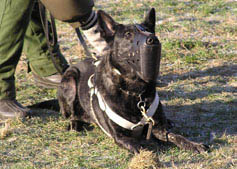
The Dutch Shepherd's Dog has not been bred for a type, he varies greatly in
appearance. Many people believe the breeding of the Dutch Shepherd's Dog should
be given stronger guidelines. This I fear would destroy this noble dog as it has
destroyed many of our other well-loved breeds. In fact it is the culmination of
all of the different types of this breed, that gives it strength and provides a
great and varied gene pool. The Dutch Shepherd's Dog in fact is one of the
finest and premier of the working breeds in the world today. The fact is you
just have to know the breeding of the dogs you are looking for and you will not
be disappointed. He makes for a great conversation piece because of his
sometimes brilliant coat coloration. It is unusual to see these dogs walking on
the street as there are not many of them in North America, and even fewer in
private homes. These dogs are considered Holland's national breed and are often
called "Dutchies" by those who share their lives. Their coat coloration goes
from a dark brindle to an orange brindle or tiger stripe. There is smooth, long
and curly coated coat types. The smooth being the most common, then long, then
curly. All are usually brindle but there are cases of black dogs as well. These
dogs can take cold weather or California type weather very well and because of
this, I am sure, will gain in popularity in the United States.
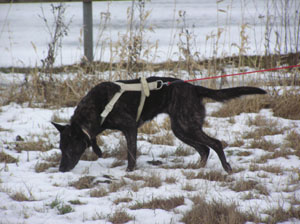
As more and more law enforcement K-9 units discover the Dutch Shepherd's Dog,
they will discover there are good ones and bad ones and really nothing in
between. By this the Dutch dog will survive. As with the Malinois the interest
in the beginning was phenomenal. Every one had to have a Malinois. Sporting dogs
went up in price as they were brought into police K-9 units. Many were found to
be handler aggressive and because of so little education on the Malinois, many
were discarded in such a way as to discourage their use by other departments.
This will, I am sure, happen to the Dutch Shepherd's Dog. Although this dog can
show great courage and at times be very aggressive, there are certain lines that
show more desire in scent work than in protection. Such a dog may be considered
unfit for patrol work and when this happens enough, all Dutch dogs will be
judged by these few. As with the Malinois, this will make them less desirable
for police work. Fortunately, I believe this will save the breed from being over
bred and over sold, a fate which has affected so greatly the German Shepherd's
Dog.
This magnificent breed makes an excellent companion and playmate. The Dutch
Shepherd's dog is a very loyal and dedicated family member. To exhibit this
protective nature I will relate an actual case. One of our employee's, which we
had given a Dutch Shepherd's pup to 5 months earlier, was working burning some
old farm fencing on our property. He had placed his female, now 7 months old,
into a 6 ft high puppy enclosure and proceeded to pour gasoline onto the wood
pile located approx. 1/4 of a mile across the fields. When he threw a match onto
the burn pile, there was a loud explosion of fumes. His young dog in concern for
her handler, cleared the fence, tracked him across the fields to make sure he
was alright. He was a bit shaken, but very happy for her company. This is only
one of many examples of the dedication and tremendous working ability displayed
by the Dutch Shepherd's dog.
If you are looking for a dedicated, intelligent and colorful companion, you
should consider the Dutch Shepherd's Dog. Suitable for Law Enforcement,
Military, home and corporate security or children's playmate, the Dutchie will
fit into many different environments. This rare breed may be difficult to find,
but a good one is well worth having.
This article comes from:http://www.badenk-9.com/tributedutch.html
Background-a
Herding and guard dog
THE
VERY BEGINNING
The forefathers of our dogs were probably wolves which were domesticated, and in
the thousands of years that followed were used for different purposes and
developed accordingly. Hunting, fighting, carrying loads and herding were just a
few of the tasks that the dogs were given. Within these groups several different
breeds came into existence and by looks and nature distinguished themselves from
other dogs. A shepherd dog is nothing more that a dog than belonged to, and was
used by a shepherd, helping him to look after the sheep or cattle. A dog with a
high level of independence was needed to keep the flock or herd together , drive
it, guard, and defend it. Some breeds were specialized in working with a certain
type of animal or a specific task, while others were all round.
The
area where the shepherd worked also had quite a lot to do with what the dog
looked like. High, bare, cold mountains required a different type of dog than
the flat lands and the more moderate temperature of the Netherlands did. Let’s
go to the Netherlands, often referred to as Holland, around the nineteenth
century. There were hardly any fenced meadows, for sheep, horses, or cattle.
Since sheep weren’t picky and the latter two were, the sheep were taken to the
heather fields by a shepherd with a dog. Almost a third of the country consisted
of sandy soil that would not grow much more than heather. The sheep that grazed
it would produce dung that in return was used to improve the soil so it could be
used for agriculture. To avoid the dung being ‘lost’ out on the heather where it
wouldn’t do the farmers much good, the sheep were driven out to the heather
during the day and returned to the stables at night. They would leave the dung
in the stable at night, and straw or heather was added before the next layer was
deposited. Thus the amount of dung grew to an extent where the sheep would be
with their backs against a ceiling that sometimes measured 12 feet or higher.
Other types of sheep were kept for meat, milk and wool, and were left to graze
by the sides of the roads since the fresh grass would improve their quality.
Here the dogs were used to drive the sheep slowly forward and keep them out of
the yards and fields that were used for agriculture. Sometimes the dogs had
other tasks beside the flock; since tending sheep could be a very meager
existence, poaching was fairly common and not without danger. Some dogs may even
have pulled small loads when they were ‘off duty’
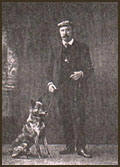 J
Steijns and "Frits"
J
Steijns and "Frits"
Frits was bought by Steijns for 2 guilders and 50cts from a farmer who was glad
to get rid of this "stupid" dog. Steijns, who was attracted by the intelligent
look of Frits, trained him in six weeks to do police work. He won the first
place prize at an international competition in Saarbrucken, Germany in 1908.
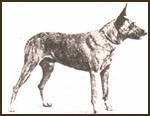
Spits van
Kralingen, 1890
Pictures borrowed from:
www.sevenpineskennel.com
Due to the replanting of forests and chemical fertilizers, the flocks of sheep
which at one point were estimated at 800,000 and worked by some 6,000
shepherd-dogs, started to disappear in the mid nineteenth century. Just in time
for our dogs, in 1898, the ‘Nederlandse Herdershonden Club’ (Dutch Shepherd
Dog Club) was formed
THE
NHC
Certainly in those early years as described above, there was no need for fancy
looking dogs. The only goal being workability, the Dutch Shepherd, or
‘Hollander’ as he is affectionately called in the Netherlands, wasn’t a breed
created to fit someone’s ideal, it just developed. As the NHC was being formed
in the late 19th century, the need for working dogs was disappearing, but a few
people could afford to keep a dog just for the fun of it. They started to worry
about conformation, and at agriculture shows, just like in Belgium, a certain
number of shepherds appeared that may have looked similar in type, but certainly
not in color. The first description of the breed allows six coat varieties;
rough haired, standing long hair, laying long hair, bristle haired, shorthaired
and medium longhaired. There was a lot of confusion in those early years. The
club was started by people that just loved shepherds, no matter whether they
were Dutch, German, Belgian, French, or whatever. Among the early members were
M. Kessler and J Steijns, two of the three founders of the future KNPV; (1907)
the Royal Dutch Police Dog Association. In those days it was possible to
enterenter a dog in a show as either a Belgian Shepherd or a Dutch Shepherd
which shows how much these two breeds were alike. Eventually there was a split,
and the club then was only for Hollandse Herders, Dutch Shepherds.
Due to the replanting of forests and chemical fertilizers, the flocks of sheep
which at one point were estimated at 800,000 and worked by some 6,000
shepherd-dogs, started to disappear in the mid nineteenth century. Just in time
for our dogs, in 1898, the ‘Nederlandse Herdershonden Club’ (Dutch Shepherd Dog
Club) was formed.Spits van Kralingen, 1890CHANGING BREED STANDARDS
Until 1914 there were a lot of changes in the breed standard. The coat varieties
were narrowed down to short, long, and rough hair. Bitches had to be a minimum
of 19 3/4’ (50cm) high, dogs 21 3/4’ (55 cm). All colors were permitted provided
that they weren’t too colorful. White however, was restricted to chest and toes.
The desire to create a breed that would clearly distinguish itself from the
German and Belgian Shepherd dogs led to a color restriction in 1914. Silver or
gold-brindle for the shorthair, silver and gold brindle, as well as pepper and
salt and blue-gray for the rough hair, and silver and gold brindle plus auburn
for the longhair. Silver being gray stripes on black, and gold being yellow or
red stripes on black. The minimum sizes for the short and rough haired varieties
were raised by about two inches, with a little less for the longhaired variety.
From that moment on all white was forbidden. Those drastic restrictions in
permitted color and/or size led to an enormous deterioration of the available
genetic material. More than anything, the exclusion of all white excluded an
enormous amount of dogs from the breed pool since white is such a dominant gene.
In Belgium however, yellow Dutch Shepherds with white markings could suddenly be
entered as Belgian Shepherds (shorthair, Malinois) since there was no
restriction of white there. Brindle Belgians could, in return, be entered as
Dutch Shepherds. In 1928 some white was permitted again, and in 1934, yellow,
red, brown, and liver were re-introduced as permitted colors for the shorthair,
with yellow and reddish brown, as well as ashen re-introduced for the rough air.
The longhair had no color changes. It was too late however.
The breed base was small and a lot of good dogs had already been excluded due to
the several color and structure changes. The clock could not be turned back
again. In 1960 the colors were restricted back to the way things were in 1914.
Only this time the auburn longhair disappeared
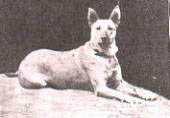
Spits, Dutch Shepherd Bitch,
pedigree reg: NPV 149
Due
to growing interest in training for police work, some breeders wanted to breed a
bigger dog. Since all look-alikes in those days could be entered as Dutch
Shepherds and since brindle is a dominant color, bigger boned dogs were bred
into the Dutch Shepherds. There are records of some GSD crosses into the
shorthaired version that occurred between 1910 and 1916. The German Shepherd in
those days was also a very young breed, and it is safe to say that the
differences between
The
German, Belgian, and Dutch Shepherds were a lot smaller than they are now.
Although the German Shepherd was still a larger dog than the Belgian and
Hollander, it resembled them much more in those days than it does now.
Though we are talking about a very limited amount of dogs in the Dutch Shepherd
population, (six DS of mixed blood) it took quite some time to get rid of the
subsequent undesirable traits. In 1892 and 1899 the Belgian Shepherds and German
Shepherds were fortunate enough to have such great admirers and leaders as
Professor Reul for the Belgians, and Max von Stephanitz for the Germans.
They made an inventory of their beloved breeds before they tried to come up with
a standard and pinpointed the desired colors. Sure, there were changes over the
years, but non so dangerous or radical as were made for the ‘Hollanders’. The
Dutch felt that they had to distinguish themselves from the very similar Belgian
Shepherds, and with the limitation of the color varieties to brindle, later
without any white, the damage was quickly done. For years the litters of the
short and rough haired versions in particular, averaged 4.6 and this had nothing
to do with fertility, but with the fact that a lot of pups were either killed
because they had the wrong colors, or they were never entered into the pedigrees
Maybe the breeders had no choice, or maybe they didn’t know in those days that
the phenotype of full siblings better reflects the genes carried by an
individual dog than the phenotype of the parents. In other words, breed two
parents with desirable color, but if you get only a few pups with that same
desirable color out of that litter, those pups that do will still have a good
chance of passing on undesirable colors to their offspring. The low average of
4.6 suggests that maybe half the litter was culled, and that almost guarantees
ongoing undesirable traits in the future litters of the ‘correct’ pups. And thus
the breed base got smaller and smaller.
After the second world war there was definitely a need for some fresh blood, and
dogs of unknown background, along with some Belgian Malinois, were suggested for
the shorthaired version, and Tervurens for the longhair. One thing was for sure
however, nobody had any desire to breed to German Shepherds again since that
little episode before the first world war had taken several years to straighten
back out.
Nowadays there are about 2000 FCI shorthaired Dutch Shepherds, about half as
many longhaired ones and the rough haired version about 3/4 of that. There are
still quite a few Dutch Shepherds of ‘unknown’ background that do not have an
FCI recognized pedigree. That doesn’t mean that no one knows where these dogs
came from though. Mainly the KNPV members in Holland breed Dutch Shepherds for
their working ability, only sometimes compromising their looks in favor of the
amazing work qualities that a KNPV dog should have. Although these dogs often
have a good deal of Belgian Malinois blood in them
Comparison
Article by Teri L Rosgaard
The Dutch Shepherd A German Shepherd In Brindle?
"The Dutch Shepherd is a medium sized, well proportioned, well muscled dog of
powerful, well balanced structure, with intelligent expression and lively
temperament." Brindle is the only recognized color. It stands between the
Belgian Shepherds and the German Shepherd in its overall appearance and in its
characther. The Shepherd Dog Breed Association, The Nederlanse Herdershonden
Club, was established in Holland in 1898. Not until about 1900 were the German,
Belgian and Dutch Shepherds given their own standards and separate registries

The
above photos depict a Dutch Shepherd on the left, this being a recent picture
taken in Holland, the picture on the right comes from the book 'The German
Shepherd Dog', a British publication by Brian H. Wootton. The brindle German
Shepherd Dog on the right was surveyed by "a body of men who were to become the
first breed surveyors".
These surveyors
were selected by Max von Stephanitz.
Beowolf

Beowolf was one of the most used foundation sires of the German Shepherd breed.
He was the grandson of SZ1 Horand vom Grafrath. The brindling (referred to at
that time as "mottling") is evident on his legs, shoulders, face and if you look
closely, even along his ribcage. Eventually breeders went strictly for sables,
blacks and black and tans so they bred away from the brindle. A color standard
was instated excluding brindle in the mid 1920's. As the Germans began to breed
for particular colors, they were breeding away from the Beowolf line and others
that carried brindle strong or were brindle themselves. These brindle dogs
started to gain popularity in Holland as they were found to have such a strong
natural herding instinct. More and more of them crossed over the border and
found acceptance, were even sought after. At the same time the Germans were
working to eliminate these great herders from their gene pool, the Dutch were
working to enlarge their number and were obtaining all of them they could from
Germany. If it hadn't been for the desire of the Dutch to own the brindle
shepherd, no doubt it would have been bred completely out of existance, as were
the spotted and wirehaired shepherd dogs that were such a large contriubtor to
the making the GSD. The Dutch Shepherd has three hair coat types, the short coat
(above), the long coat and the rough coat pictured below


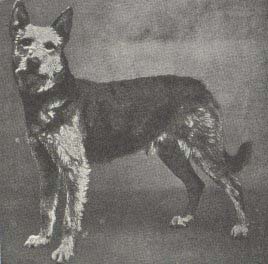
Just for comparison...here are two photos of wire (rough) coat german shepherds
from the early 1900's (in Germany)
According to the Dutch Shepherd standard, it is "affectionate, obedient,
tractable, alert, very faithful and reliable, undemanding, with plenty of
stamina, vigilant, active and gifted with the true shepherd temperament." It is
loyal towards all family members but will choose one alone for it's highest
loyalty. Raised properly it will be an alert, smart and loyal dog. It has a will
of its own and must know its place but does not handle unfair punishment well.
There is a definate separation between the show and working Dutch Shepherds in
Holland and you must know which you are after before making a purchase. Dutch
Shepherds have been seen allot in the Military for many years and are gradually
becoming more popular with Police K-9 Units around the world. It's not uncommon
for the European Police and military Dutch Shepherds to be crosses between the
Dutch Shepherd, the German Shepherd and the Malinios. And it's surprisingly easy
to tell at a glance which dogs are more of which breeds (in many cases).
Dutch Shepherds, like Malinois, are seen more in Ring Sport, KNPV etc., than
they are in Schutzhund. Like any other breed, they are not the dog for everyone,
some are very high energy and need to be kept busy, some are very civil, some
are hard headed and require a person to stay a step ahead of them at all time.
Weak nerves are not uncommon in the show lines. On the other hand, they are
extremely intelligent, very handsome and have many laughable personalities.
Their level of agility is alomst unreal. The breed is just taking hold in
America and care must be taken to research anyone you consider purchasing one
from as throughly as possible.
American Dutch Shepherd Club
19123 Yontz Road
Brooksville, FL 34601
Credit where credit is due......
www.sevenpineskennel.com
picture of the Modern Dutch Shepherd...
J.Schmidt, Holland
pictures of the Brindle GSD and Beowolf
...Brian Wootton, 'The German Shepherd Dog'
pictures of the Long Coat and Rough Coat Dutch Shepherds...
Dr. L.F. Triebels, 'De Hollandse Herder'
This article is *copyright* and all rights are reserved by the author....
Teri L. Rosgaard

 J
Steijns and "Frits"
J
Steijns and "Frits"




